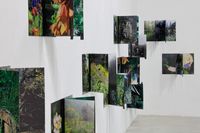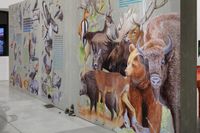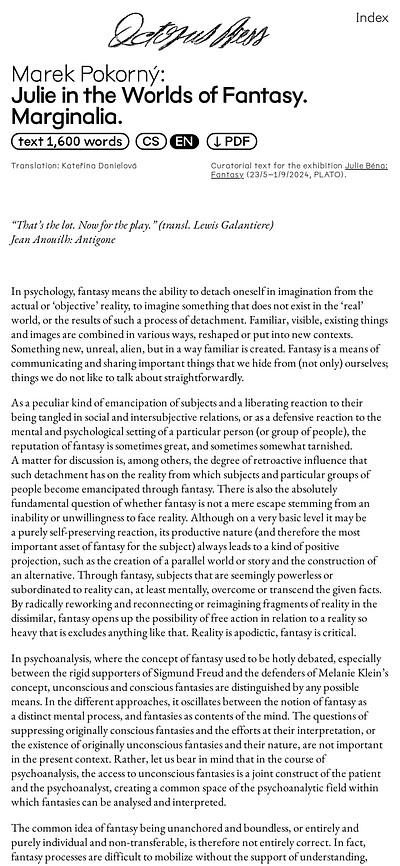Primeval Forest, Garden and Wall
Translation: Marta Darom
Tłumaczenia: Izabela Szulc
Curatorial text for the exhibition Primeval Forest, Garden and Wall (17/10/2024-26/1/2025, PLATO).
Primeval Forest, Garden and Wall is the second exhibition organized in the Keyhole space that focuses on various forms of gardening as well as art related to plants. The motivation for the exhibition was the archive of photographs and negatives of Lech Wilczek (1930–2018): while researching materials for the (previous) exhibition Escaped, Found a Hideout, Still on the Run, I came across the archival photographs of Wilczek’s garden in Dziedzinka, in the Białowieża Forest, where he lived with Simona Kossak in an interspecies family with domesticated and wild animals. While the story of the zoologist, ecologist, activist and ethologist Kossak (1943–2007) is known to the informed public (a feature film on her life in the forest will come out in cinemas this year), the activities of her partner Wilczek – a graduate of the Academy of Fine Arts in Warsaw, an observer and documentarist of the animals, plants, and people in his surroundings – are not. Just like the biotope of his garden where flora and fauna species were interconnected and functioned together, his photographs show his longing for a complete and interconnected image of the world and the individuals who create it. Wilczek’s photographs received acclaim in Poland and elsewhere. In the 1950s and 1970s, he published books on mushrooms, hamsters, aquarium fish, ravens, tawny owls, and badgers, while also writing articles for the monthly Przyroda Polska. Commenting on Wilczek’s first book Oko w oko, Adam Mazur and Lukasz Gorczyca wrote: “Unlike the most famous photographers of nature of the Polish People’s Republic, such as Włodzimierz Puchalski and Zdzisław Wdowiński, Wilczek was not a hunter. He represented an environmental attitude that was rare among his photographer colleagues.” Both Wilczek and Kossak were environmentalists. Contemporary witnesses from Białowieża say that Wilczek was more connected to the locals, while Kossak fought for the rights of the primeval forest – fighting in the media, fighting with authorities, and sometimes even with the locals. She wanted to save the wolves, lynxes, bison, and other animals that humans push out of the forest (or indeed any) landscape.
Wilczek’s enthralling garden photographs that I found in the archive were like a revelation to me – to start with, the garden was in the protection zone of the primeval forest! I invited field biologist and landscape ecologist Jan Albert Šturma to co-curate the exhibition with me. Šturma is also an opponent of the wall – the anti-migration barrier, over five meters tall and 186 km long, that Poland is erecting along its border with Belarus. The wall is a major humanitarian and environmental problem: it significantly limits the movement of rare species, including bison, moose, and lynx, even though the Białowieża Forest is a UNESCO World Heritage Site and part of the European Natura 2000 network of protected areas. As I sorted through the photo archive stored in the house of Simona’s niece Joanna Kossak located in the middle of the primeval forest, Lech’s photographs clashed with the reality outside the windows, laden with begonias. The view of Polish Army soldiers and vehicles patrolling in front of the house and driving through the entire forest de-romanticized any interspecies dreams of the garden in Dziedzinka.
The exhibition explores the theme of the artificial construction of borders with which people separate one nature from another: the nature of the Polish primeval forest from the nature of the Belarusian primeval forest, the nature of the artificial garden from the nature of the original forest. In Dziedzinka, Wilczek created the garden organism while he observed the primeval forest organism which surrounded the garden. The garden in Dziedzinka was not created merely to please people; it was also a source of food for insects, birds, reptiles, mammals, the organisms living in the soil, and the many plants that thrived in it. For Wilczek and Kossak the garden also served as a place for scientific observation and photo documentation. The garden was a collective work made up of the many gardens and front gardens of Białowieża and its surroundings. On the way home from his Warsaw studio (where Wilczek created and maintained a garden with a pond for the inhabitants of the house), gardeners were happy to give him gifts of plant offsets and bulbs, as did people from Białowieża. In return, he would give them something from his garden paradise. Wilczek had a talent for getting young people interested in gardening, especially students from the local forestry school who would come and help him in the garden while learning gardening. This is how Mirosław Jerzy Chyra, who became friends with Wilczek, succumbed to the passion of gardening – just like Chyra’s son Jarosław later on. Together they organised the book Ogród Puszczy towards the end of Wilczek’s life. The book will be published this year and we are honoured to have its pilot version in the exhibition.
The garden in Dziedzinka is of interest to PLATO for many reasons. Its concept is close to the permaculture principles which influence the PLATO garden, and both gardens weave together artistic, gardening, environmental, educational, and ethical goals.
Biophilia (people’s innate tendency to seek a connection with nature and other forms of life) has been replaced by biopolitics (power over the lives of others). When Kossak and Wilczek moved from Dziedzinka to Białowieża in their old age to live there permanently, the authorities ordered them to destroy the garden, including the beehives and the shelters for their animals. Kossak and Wilczek understood that plants from the garden could spread into the virgin forest and agreed to the garden’s destruction. A part of the garden has survived in the gardens of the village and Chyra’s garden. But recently, other authorities have approved – about a kilometre further on – a construction that is far scarier for the life of the primeval forest than a garden: a wall embedded in the ground and so tall that almost no man or animal can dig under it or climb over it. The wall divides plant and animal species into those that can get over it and those that have no chance. From a biological perspective, migration is a natural thing, necessary for the life of organisms and to preserve healthy genes. However, the political division of the world interprets it with increasing consistency as unnatural and uses it as a tool for power struggles and a fight for votes. Jan Albert Šturma has invited illustrator, director, and screenwriter of documentary and popular science-themed films, Jan Hošek, with whom he collaborated on the film Planeta Praha, to be co-curator of the exhibition. The result of the collaboration is a wall with Hošek’s drawings and Šturma’s texts that divides the Keyhole space and points out the traumatizing effect such an unsurpassable obstacle has on the forest animals. The viewers are welcome to get actively involved on one side of the wall and express their opinions, thus symbolically supporting the efforts of many humanitarian and environmental activists who are active in Białowieża, in government offices, and in the media.
Edith Jeřábková, Jan Albert Šturma
- Language
- Type
- Palate Cleanser2025
- cs
- en
text- 2,000 words
- Monika Pascoe Mikyšková: Memories that aren’t mine2025
- cs
- en
text- 500 words
- Kino Kosmos under the Cosmic Sun2025
- cs
- en
text- 9,800 words
- Kino Kosmos2025
- cs
- en
text- 3,700 words
- Dorota Jurczak: Pyk, Sciak etc.2025
- cs
- en
text- 1,500 words
- Sprouts2025
- cs
- en
text- 800 words
- Curatorial text for the exhibition by Petr Bosák, Robert Jansa and Adam Macháček2025
- cs
- en
text- 900 words
- Curatorial text for Martin Zetová's exhibition2025
- cs
- en
text- 1,100 words
- Cello & Piano2025
- cs
- en
audio - Primeval Forest, Garden and Wall2024
- cs
- en
- pl
text- 1,100 words
- Interview with Barbora Lungová2024
- cs
audio - Barbora Lungová and the gift of painting2024
- cs
- en
text- 1,400 words
- Julie in the Worlds of Fantasy. Marginalia.2024
- cs
- en
text- 1,600 words
- Pigeon newspaper2024text
- Workbook for children The Shell No. 32024
- cs
- en
text- 200 words
- Zvířecí kustodi – Bee2024
- cs
- en
video- 32’32”
- Animal Custodians – Rabbit2024
- cs
- en
video- 33’18”
- Animal Custodians – Owl2024
- cs
- en
video- 28’05”
- Animal Custodians – Fox2024
- cs
- en
video- 32’05”
- Animal Custodians – Deer2024
- cs
- en
video- 33’45”
- Animal Custodians – Pigeon2023
- cs
- en
video- 32’20”
- Animal Custodians – Raven2023
- cs
- en
video- 21’24”
- If you have a canary with a poor singing voice, it will never stop singing after this training video!2023
- cs
- en
video- 21’24”
- Checking the Stove2023
- cs
- en
video- 5’34”
- 0’40”
- Trust2023
- cs
- en
video- 7’03”
- Is it the flight or the fall what my friend is falling for?2023
- cs
- en
video- 12’08”
- Animal News2023
- cs
- en
text- 1,500 words
- Dan Walwin: Relief2023
- cs
- en
text- 1,000 words
- Ukrainian Culture at the Time of Russian Aggression2023
- cs
- en
text- 100 words
- Freely Accessible Books on the Topic of Ukrainian Culture at the Time of Russian Aggression2023
- cs
- en
text- 500 words
- They Thought We Were Alive and They Run Screaming2023
- cs
- en
text- 1,200 words
- On Renewed Land: Locating Ukrainian Destiny2023
- cs
- en
text- 1,900 words
- I Can Hear the Grass Grow2023
- cs
- en
text- 600 words
- Interview related to the exhibition Optimised Fables about a Good Life2022
- cs
- en
text- 900 words
- Interview related to the exhibition Optimised Fables about a Good Life2022
- cs
- en
text- 900 words
- Interview related to the exhibition Optimised Fables about a Good Life2022
- cs
- en
text- 700 words
- Interview related to the exhibition Optimised Fables about a Good Life2022
- cs
- en
text- 1,700 words
- Interview related to the exhibition Optimised Fables about a Good Life2022
- cs
- en
text- 1,000 words
- Interview related to the exhibition Optimised Fables about a Good Life2022
- cs
- en
text- 1,100 words
- Interview related to the exhibition Optimised Fables about a Good Life2022
- cs
- en
text- 900 words
- Interview related to the exhibition Optimised Fables about a Good Life2022
- cs
- en
text- 1,600 words
- Interview related to the exhibition Optimised Fables about a Good Life2022
- cs
- en
text- 900 words
- Interview related to the exhibition Optimised Fables about a Good Life2022
- cs
- en
text- 1,400 words
- The Night2022
- cs
text- 0 words
- Optimised Fables about a Good Life2022
- cs
- en
text- 800 words
- In the footsteps of the Greek underground II: Longing for deep time2022
- cs
- en
text- 7,200 words
- In the footsteps of the Greek underground I2022
- cs
- en
text- 12,800 words
- Elective Affinities: “Anarchism Without Adjectives”. On the Work of Christopher D’Arcangelo 1975–1979 with Dean Inkster and Pierre Bal-Blanc2022
- cs
- en
video- 58’01”
- Curatorial Control2022
- cs
- en
text- 2,500 words
- Ruins. Reconstruction of the past and construction of the future2022video
- 1h 14’43”
- Long Evening with Octopus Press2022
- cs
audio - Oh and Hah, Beauty, Ruin and Slack2021
- cs
- en
text- 900 words
- Our Living Ruins2021
- cs
- en
- pl
text- 3,100 words
- Troubling Time/s and Ecologies of Nothingness: Re-turning, Re-membering, and Facing the Incalculable2021
- cs
- en
text- 16,400 words
- Re/un/doing the Ruin2021
- cs
- en
text- 2,800 words
- Usableness of the list / Portfolio2021
- cs
- en
audio - Tied to Landscapes2021
- cs
- en
text- 800 words
- Tied to Landscapes2021video
- 9’49”
- A Small Encyclopedia of Improprieties2021video
- 12’18”
- Humans need not apply2021
- cs
- en
text- 900 words
- Poems2021
- cs
- en
text- 200 words
- Carbon Care2021
- cs
- en
text- 1,400 words
- Bouvard and Pécuchet. A Tragi-comic Novel of Bourgeois Life2021
- cs
- en
- fr
text- 12,300 words
- And Again G. F.2021
- cs
- en
text- 700 words
- On The Immortality of Art Institutions2021
- cs
- en
- pl
text- 1,500 words
- Expedition PLATO2021video
- 47’25”
- The Great Transformation. The Political and Economical Origins of Our Time2021
- cs
- en
text- 4,800 words
- Digestive Tract2021video
- 14’35”
- Notre Dame of Ruins2021
- cs
- en
- fr
text- 1,100 words
- Who is Afraid of Ruins?2021
- cs
- en
- pl
text- 1,300 words
- The Ruin2021
- cs
- en
- de
text- 3,000 words
- Zapomínání a infrastruktura2021video
- 13’19”
- Forgetting and infrastructure2021
- cs
- en
text- 2,000 words
- Olympia2021image
- Purification II, 20202021video
- 3’35”
- Purification I, 20202021video
- 1’49”
- Chaos: how to ruin a ‘ruin’ and love a ‘ruin-in-love’, I think2021
- cs
- en
text- 5,400 words
- (Introduction) Chaos: how to ruin a ‘ruin’ and love a ‘ruin-in-love’, I think2021video
- 13’35”





